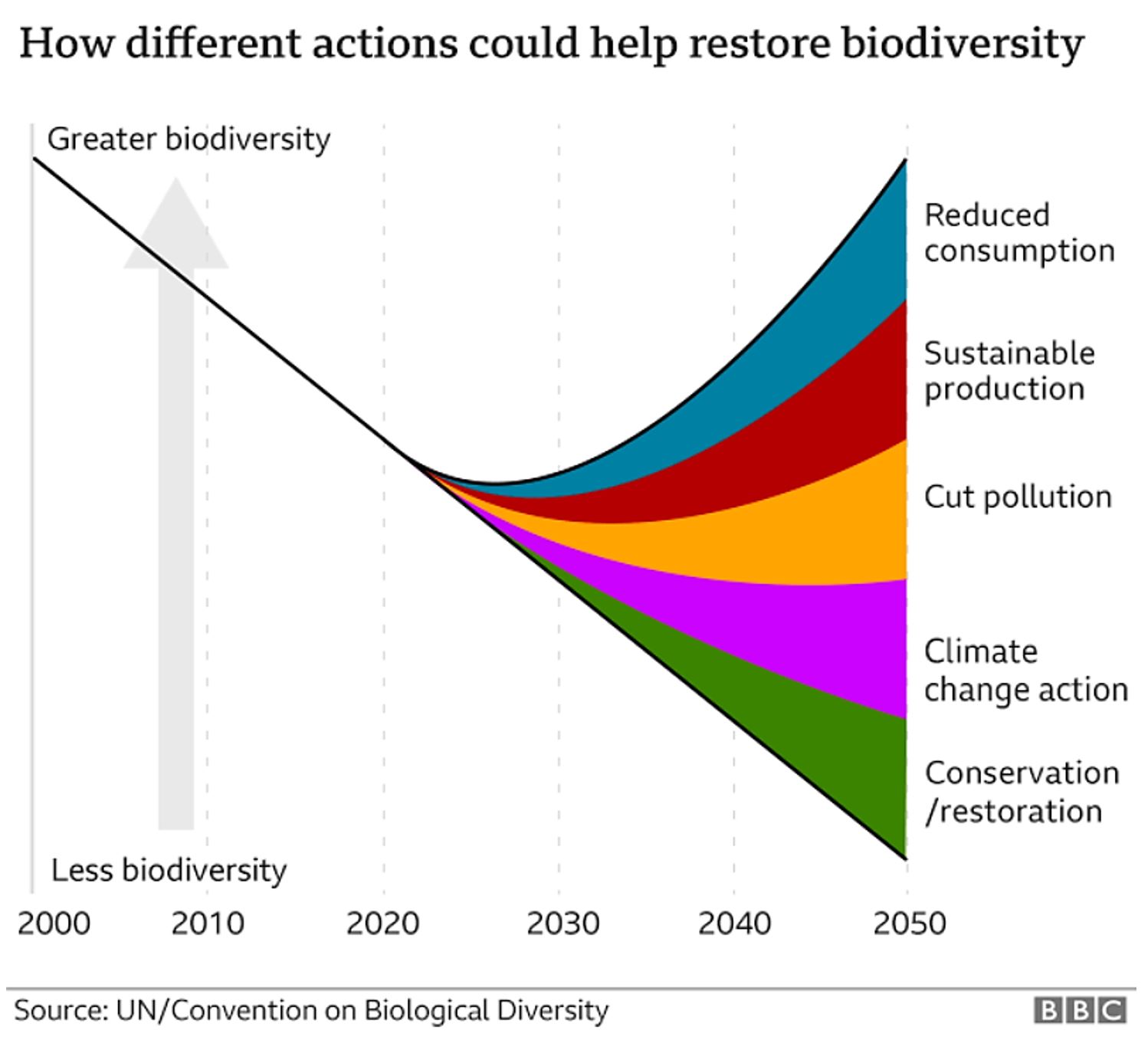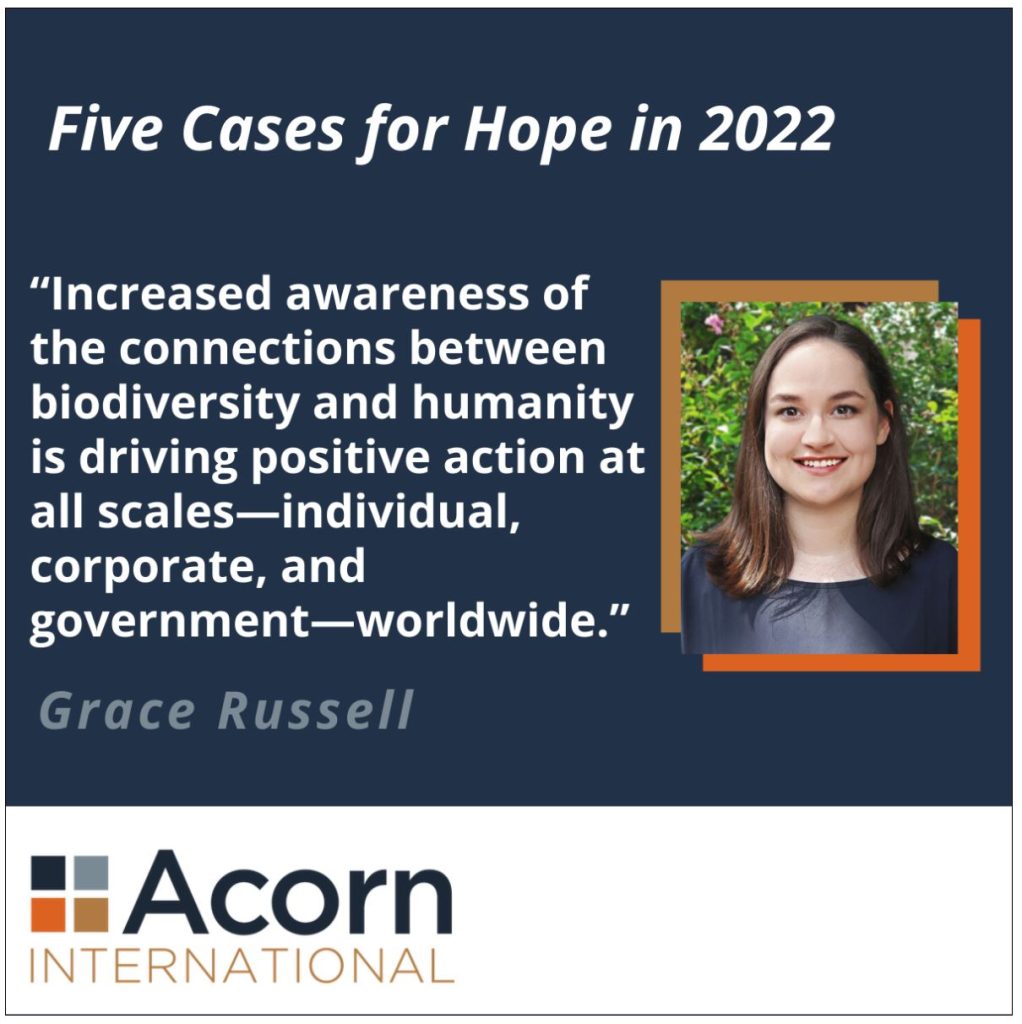5 Cases for Hope in 2022: #3 Biodiversity
This is the 3rd of a series of 5 posts on “5 Cases for Hope in 2022” – see https://www.linkedin.com/company/2257207
Since the new year, we’ve been posting a series of posts about global ESG crises we face – and making a case for reasons to be hopeful amidst all the gloom. This is not in any way to minimize the reality and gloomy impact of these crises or diminish the need for urgent action to address them – but rather to help us all find some added energy for progress through hope. This week’s crisis and subject for hope: biodiversity.
The UN estimates that a million wildlife species are threatened with extinction and that 1.9 square kilometers of natural habitat (about 8 times the size of the UK) have been lost since 2000. Most of the biodiversity conservation targets set during that year’s global Convention on Biodiversity (CBD) in Aichi, Japan for 2020 have not been met. But there are reasons to hope for “changing the curve” starting with this year’s CBD conference – COP15, happening in the wake of the global climate conference in Glasgow.
Alarm Bells May Finally Be Noticed
COP15 brings increased awareness of the urgency for action and opportunity for more binding commitments (similar to those struck in Glasgow) as well as greater international financing to stop and reverse biodiversity loss. To help fuel this Post-2020 Global Biodiversity Framework, for example, China committed $230 million and multi-lateral banks are enabling financing mechanisms to accelerate capital to countries where the risk is particularly high and the capacity for managing it is particularly limited.
In the closing days of 2021 the world lost two of its biodiversity conservation pioneers, E.O. Wilson and Thomas Lovejoy, but their deaths brought global attention to their work and to the urgent work left to be done.
30 by 30
Biologist E.O. Wilson famously called for the conservation of 50 percent of the planet to safeguard further loss of biodiversity. While that target did not receive broad support, there is significant momentum building towards meeting a different milestone. A recent Guardian article noted: “Governments are expected to commit to a Paris-style agreement for nature at COP15 in Kunming, China, later this year, with targets that include protecting at least 30% of the oceans and land by 2030.”[1] US President Biden has committed to an aligned 30 by 30 policy, and the Administration has initiated a Climate Conservation Corps to help engage Americans to meet the target.
Coordinated Response
Scientists studying the draft Post-2020 Framework recently warned that designating more land and water for conservation will not be enough to stop the loss of biodiversity. “Needed is successful, coordinated action across a diverse, interconnected set of ‘transformative’ changes, including massive reductions in harmful agricultural and fishing subsidies, deep reductions in overconsumption, and holding climate change to 1.5° C.”[2]
The chart from the UN below shows how progress on these factors can be expected to restore biodiversity on the planet. None of these actions will be easy, but governments, industry and financial institutions are already working together on tangible plans to “change the curve”[3] on four of these factors. Reducing consumption still needs urgent attention and incentivization for behavioral change, particularly in the US.

Nature’s Best Hope?
 If you think we are being terribly optimistic about progress on the biodiversity crisis, consider the words of the noted biologist and author Douglas Tallamy. Tallamy calls for us to think globally and act locally on biodiversity conservation by preserving and planting native vegetation in each of our own properties, taking the crisis and its solutions to a personal and family level. His encouragement: “…we have learned that restoring our natural world benefits not only other species, but Homo sapiens as well, in ways no one imagined only a few years ago. …It is quite possible that future historians will call the coming decades ‘The Age of Ecological Enlightenment.’ “[4]
If you think we are being terribly optimistic about progress on the biodiversity crisis, consider the words of the noted biologist and author Douglas Tallamy. Tallamy calls for us to think globally and act locally on biodiversity conservation by preserving and planting native vegetation in each of our own properties, taking the crisis and its solutions to a personal and family level. His encouragement: “…we have learned that restoring our natural world benefits not only other species, but Homo sapiens as well, in ways no one imagined only a few years ago. …It is quite possible that future historians will call the coming decades ‘The Age of Ecological Enlightenment.’ “[4]
We can hope that Tallamy is right – and more immediately, we increasingly have the mechanisms and awareness to start making greater progress today.
[1] Greenfield, Patrick. 2022. “Expanding national parks not enough to protect nature, say scientists”. The Guardian. 19 January 2022. Available at: https://www.theguardian.com/environment/2022/jan/19/expanding-national-parks-not-enough-to-protect-nature-say-scientists-aoe, last accessed 25 January 2022.
[2] Group on Earth Observations Biodiversity Observation Network. 2022 “Scientists urge quick, deep, sweeping changes to halt and reverse dangerous biodiversity loss”. Phys.org. 19 January 2022. Available at: https://phys.org/news/2022-01-scientists-urge-quick-deep-halt.html, last accessed 25 January 2022.
[3] Ervin, Jamison. 2020. “Bending the Curve on Biodiversity Loss Requires Nothing Less than Transformational Change”. UNDP Blog. 23 September 2020. Available at: https://www.undp.org/blog/bending-curve-biodiversity-loss-requires-nothing-less-transformational-change, last accessed 25 January 2022.
[4] Tallamy, Douglas W. 2019. Natures Best Hope – A New Approach to Conservation That Starts in Your Yard. Portland, OR: Timber Press.
News & Notes

Acorn International
1702 Taylor St, Suite 200B
Houston, TX 77007, USA
1213 Purchase St
New Bedford, MA 02740, USA
